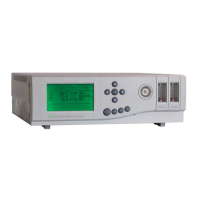5.1
SECTION 5 MAIN CONFIGURATION
5.1 Alarms
The xentra has four user configurable concentration software alarm settings for each
gas sensor module fitted. These are referred to as AL1, AL2, AL3 and AL4. Each alarm
may be enabled or disabled. On first power up of the instrument the default state of the
alarms is that they are disabled. For each alarm of each gas sensor module which is
enabled, the following parameters need to be set up:-
i) Freeze alarm state during calibration or alarm as dictated by calibration
sample concentration.
ii) High concentration alarm or low concentration alarm.
iii) The concentration level at which the alarm is to occur (alarm level).
iv) Hysteresis (see below).
See Table 5.1 for procedure.
The alarm hysteresis is used to set a dead band so that the alarm does not ’chatter’
when the sample concentration level is similar to the alarm level.
For a high alarm, the alarm will be initiated when the sample concentration rises above
the alarm level. The alarm will be cleared when the sample concentration falls further
below the alarm level than the value of hysteresis set. ie the hysteresis band sits directly
below the alarm level
For a low alarm the alarm will be initiated when the sample concentration falls below the
alarm level and will be cleared when the sample concentration rises further above the
alarm level than the value of hysteresis set. ie the hysteresis band sits directly above
the alarm level
The alarm hysteresis level is specified in terms of the full scale deflection ( FSD ) for the
transducer concerned. The FSD values for the transducers fitted within the xentra
4900 are given in section 1.8. The maximum value of hysteresis is 5% of the FSD.
Allocation of the alarms to a relay is covered in 5.2 ’Allocation of relays’.

